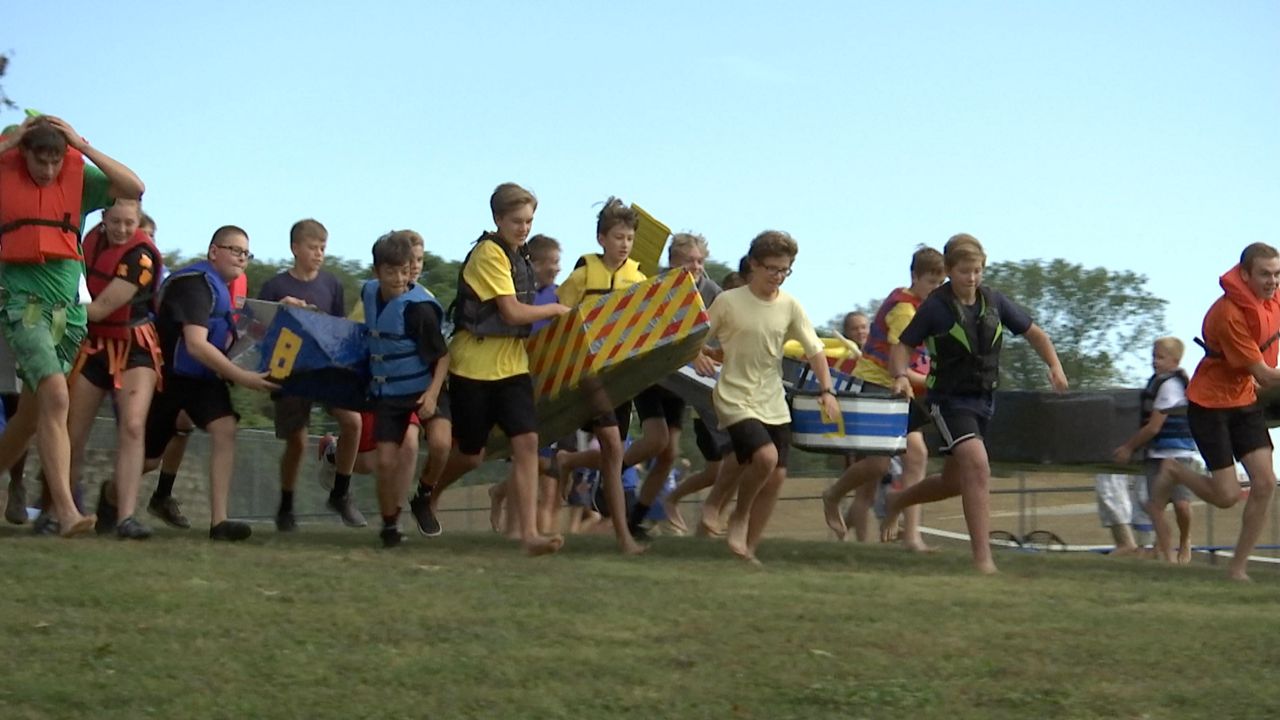VILLA HILLS, Ky. — It was a battle of pure will, cardboard and duct tape Friday in Villa Hills.
Students at Villa Madonna Academy High School and Junior High competed in the school’s annual Cardboard Boat Regatta.
What You Need To Know
- Students at a Northern Kentucky school competed in a cardboard boat race
- Villa Madonna Academy students built their own boats using only cardboard and duct tape
- While some students were competing for an engineering grade, the competition was open to all others in grades 7-12
- The teacher who came up with the event says it teaches students engineering skills, as well as creativity
Chemistry, physics and engineering teacher Mark Wolff came up with the idea about five years ago.
“I was teaching an engineering class, and I said, 'OK, this is what we’re going to do. We’re going to have a boat race. So you have to design and build a cardboard boat,'” Wolff said.

As the whole school watched, students made a mad dash to the lake outside Villa Madonna Academy, carrying with them the boats they’ve spent weeks meticulously crafting.
Once they made it into the water, which was fairly cold on the first of October, it was full steam – or full paddle – ahead. For others, whose boats didn’t hold up as well, it was more like the scene from The Titanic when Rose had to let Jack go.
Wolff, a retired engineer himself, said takes great pride in the organized chaos. He explained the rules.
“They’re allowed to use a couple of dowel rods that I supply to give them a little structural support, or for paddles if they want to use paddle handles. Other than that it’s all cardboard and duct tape,” he said.
“So the engineering students have to do the physics calculations of Archimedes’ principle to decide how deep their boat’s going to go in the water, how big they want to build it, how much they’re going to load it," Wolff added
Sailors have to factor in stability and their vessel's center of gravity, and they never get to test them before the big race. Students do get to build a prototype miniature to test calculations, and then scale it up.

“A big part of the learning is the construction. When design meets construction, you have to start making other decisions,” Wolff said.
The event consists of two heats. The first is just for engineering students, who were competing for a grade in a class that’s dual credit with the University of Cincinnati. Engineering students document all of their work in a notebook, which Wolff grades.
The second heat is open to all other students in grades 7-12.
Juniors Keegan Davis and Ian Halpin took first place in the engineering class race.
“Feeling pretty excited. We had a rough start at the beginning, but then towards the middle and towards the end we were doing pretty good,” Davis said.
When asked if their success came from the strength of their boat, or their racing prowess, Halpin said, “I’d say it was probably like 75% the boat, and 25% the racing part of it, because I felt like ours was much sturdier than some of the other boats.”
Davis and Halpin’s third teammate, Kathryn McLagan, also had her sights set on winning the open heat for the third year in a row with her fellow junior Sophie Schaeffer.
And they did indeed win by a wide margin in the same exact boat they built as freshmen: The Valkyrie.
“We both get a little bit nervous every year because the boat does get a little bit wet, so we have to reinforce it each year, and we’re really hoping every year there’s no leaks, because even if you have one leak you can go down,” McLagan said. “We’ve done a few reinforcements, just like extra layers of cardboard and duct tape on the inside. So that the structure doesn’t cave in or anything.”
McLagan explained the secret to their overwhelming success in the race, which included a mix of luck and YouTube.
“We spent like 20 hours on this freshman year, and it’s paid off, because we’ve been able to use it for so many years now,” she said. “You can definitely make a great boat and mess it up by your rowing, or how you get in. A lot of people capsize themselves when they get in, or they bump into another boat.”
“It’s really cool that you get to use your engineering design and just come up with things, and make something that’s your own, and then to see it succeed is just like the best feeling ever,” she said.
Schaeffer explained their construction process of ensuring each piece of cardboard was wrapped in duct tape twice.
“We also wrapped every single piece of cardboard in like two layers of duct tape before assembling," she said. "You go crisscross on the duct tape so there’s like no room for leaks.”
“Our rowing used to be very bad. We’ve definitely improved. We worked on it. Hopefully next year it’ll be perfect,” Schaeffer said.
The dynamic duo will be going for four wins in a row next year. Wolff said he’ll keep doing the event for as long as he can.
“These are really great kids, and their enthusiasm is evident. And it’s fun working with them, teaching them what I know,” he said.



